Related Research Articles
The Pilbara is a large, dry, thinly populated region in the north of Western Australia. It is known for its Aboriginal peoples; its ancient landscapes; the red earth; and its vast mineral deposits, in particular iron ore. It is also a global biodiversity hotspot for subterranean fauna.
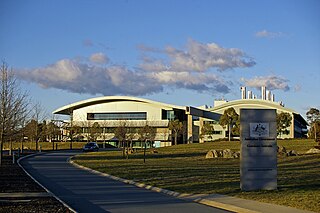
Geoscience Australia is an agency of the Australian Government. It carries out geoscientific research. The agency is the government's technical adviser on all aspects of geoscience, and custodian of the geographic and geological data and knowledge of the nation.

The Queen River, part of the King River catchment, is a minor perennial river located in the West Coast region of Tasmania, Australia. It is notable for its high level of pollution caused by mining runoff which has led the river to be uninhabitable to life.
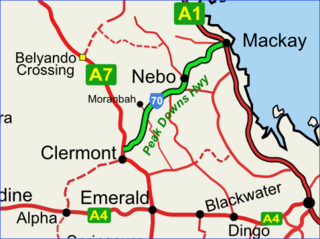
The Peak Downs Highway links the towns of Mackay and Clermont in the Australian state of Queensland. It represents the main link between Queensland's Whitsunday Coast and the Central West region of the state. The highway runs for a total length of 266 kilometres (165 mi), before joining the Gregory Highway south to Clermont, a total of 283 kilometres (176 mi). Major settlements served by this route include Walkerston, Nebo, Moranbah and Clermont.

Mining in Australia has long been a significant primary sector industry and contributor to the Australian economy by providing export income, royalty payments and employment. Historically, mining booms have also encouraged population growth via immigration to Australia, particularly the gold rushes of the 1850s. Many different ores, gems and minerals have been mined in the past and a wide variety are still mined throughout the country.
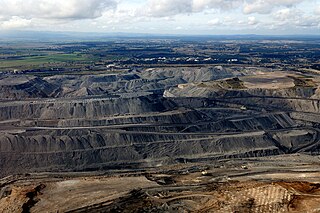
Coal is mined in every state of Australia. The largest black coal resources occur in Queensland and New South Wales. About 70% of coal mined in Australia is exported, mostly to eastern Asia, and of the balance most is used in electricity generation. In 2019-20 Australia exported 390 Mt of coal and was the world's largest exporter of metallurgical coal and second largest exporter of thermal coal. While only employing 50,000 mining jobs nationally coal provides a rich revenue stream for governments.

Fortescue is a global metal mining and green energy company headquartered in Australia. Fortescue focused on iron ore mining under the name of Fortescue Metals Group until July 2023. As of 2017, Fortescue is the fourth-largest iron ore producer in the world. The company has holdings of more than 87,000 km2 in the Pilbara region of Western Australia, making it the largest tenement holder in the state, larger than both BHP and Rio Tinto.
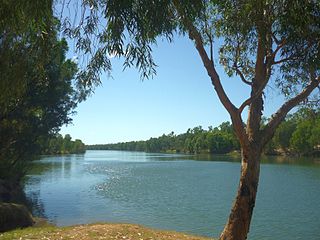
The McArthur River is a river in the Northern Territory of Australia which flows into the Gulf of Carpentaria at Port McArthur, opposite the Sir Edward Pellew Group of Islands. The river was named by Ludwig Leichhardt while he explored the area in 1845. He named the River after James MacArthur and the MacArthur family of Camden, who were enthusiastic supporters of his expedition. The McArthur River has significance for the local Aboriginal communities, who use it for fishing and other traditional activities.
Perry River Dam is a dam in Queensland, Australia, located 68 kilometres (42 mi) south west of Bundaberg. The dam is a roller compacted concrete embankment 12m high and 104m long. From a catchment area of 98 km2 it impounds a maximum of 1,050 megalitres.
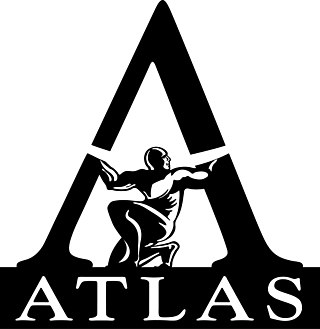
Atlas Iron is an Australian mining company and an iron ore explorer, developer and producer, predominantly active in the Pilbara region and is owned by Redstone Resources, a fully owned subsidiary of Hancock Prospecting. The company operates three iron ore mines in Western Australia. In 2018 Atlas will expand its operation to start processing Lithium in a deal with Pilbara Minerals.
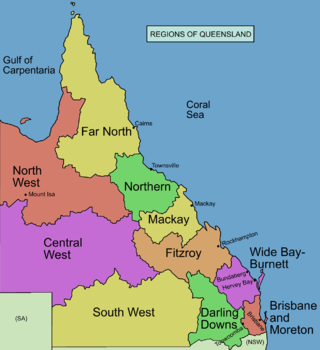
The Gulf Country or North West Queensland is the region of woodland and savanna grassland surrounding the Gulf of Carpentaria in north western Queensland and eastern Northern Territory on the north coast of Australia. The region is also called the Gulf Savannah. The Gulf Country is crossed by the Savannah Way highway.

The Annan River is a river in the Wet Tropics of Far North Queensland, Australia.
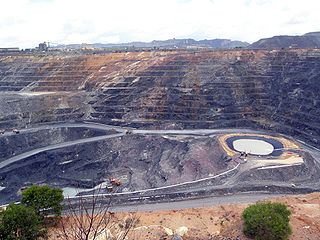
Radioactive ores were first extracted in South Australia at Radium Hill in 1906 and Mount Painter in 1911. 2,000 tons of ore were treated to recover radium for medical use. Several hundred kilograms of uranium were also produced for use in ceramic glazes.
The Department of Mines and Petroleum was a department of the Government of Western Australia until it was superseded by the Department of Mines, Industry Regulation and Safety on 1 July 2017. The department was formed on 1 January 2009, out of the former Department of Industry and Resources and Department of Consumer and Employment Protection, which were split into three new departments, the Department of Mines and Petroleum, the Department of State Development and the Department of Commerce.

Iron ore mining in Western Australia, in the 2018–19 financial year, accounted for 54 percent of the total value of the state's resource production, with a value of A$78.2 billion. The overall value of the minerals and petroleum industry in Western Australia was A$145 billion in 2018–19, a 26 percent increase on the previous financial year.
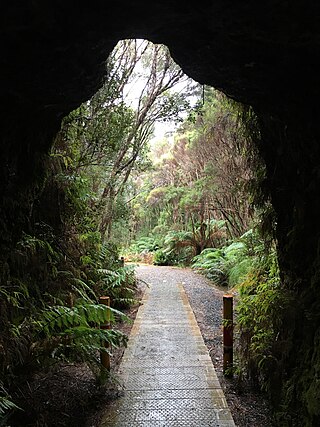
Mount Zeehan is a mountain in Western Tasmania, west of the West Coast Range. It has an elevation of 701 metres (2,300 ft) above sea level. The closest town is Zeehan, about 4.93 kilometres (3 mi) away.
The Dee River is a river in Central Queensland, Australia.
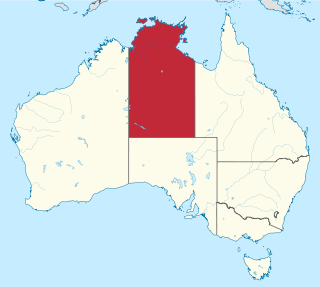
Mining in the Northern Territory accounts for 16.4% of the gross domestic product, inclusive of both the minerals and petroleum industries. In 2015, it was valued at A$3,436 million. It accounts for 4.3% of the Northern Territory workforce. 63 businesses are currently engaged in the sector.

Bald Hills is a locality in central Victoria, Australia, in the Hepburn Shire local government area, 107 kilometres (66 mi) west of the state capital, Melbourne, and 14 kilometres (8.7 mi) north of Ballarat. The area is about 442 metres (1,450 ft) above sea level.
The Miralga Creek mine is an iron ore mine operated by Atlas Iron and located in the Pilbara region of Western Australia, 100 kilometres (62 mi) south-east from Port Hedland. Ore from the mine is transported overland via road train to the Utah Point Bulk Commodities Berth at Port Hedland.
References
- ↑ "Geoscience Australia Portal". portal.ga.gov.au. Retrieved 26 November 2023.